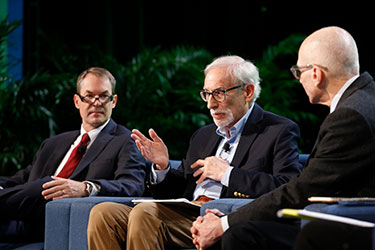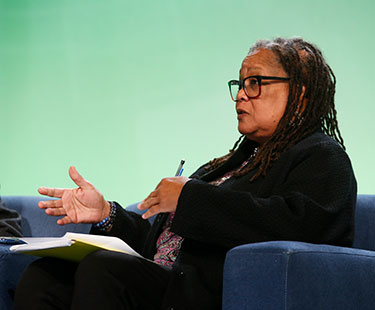APHA has been at the forefront of U.S. public health since its founding, from sanitation and civil rights to seatbelt laws and access to health care.
At Monday’s General Session, “150 Years of Public Health History,” U.S. public health was explored from a historical perspective, the topic falling neatly into APHA 2022’s celebration of the Association’s sesquicentennial.
Panelists highlighted how public health’s history relates to and informs today’s public health challenges. But they also acknowledged disturbing U.S. trends that affect public health today that have little precedent in the field’s history. 
Theodore Brown, a professor emeritus of history in the School of Medicine and Dentistry at the University of Rochester and coauthor of the new APHA Press book “Public Health Then and Now: Landmark Papers from AJPH,” compared and contrasted the U.S. 1918-1919 influenza pandemic with the COVID-19 pandemic.
For COVID-19, health officials had the advantage of highly effective vaccines and antivirals compared to 100 years ago, Brown said. Another key difference was that that, in the early 20th century, public health was uniformly supported by state and federal officials and the public. Successes in vaccination, reducing disease, creating cleaner drinking water and better sanitation showed the strength of public health for the common good, Brown said.
But in recent years, public trust has eroded and many politicians have weaponized public health for their own political gain, he said. The courts have also become more partisan.
“Public authority was respected and supported by the courts,” Brown said of the early 20th century. “Now, the Supreme Court and other courts question the police power of the state, (reflecting) part of the decline of public health authority.”
 Lawrence Gostin, a professor at Georgetown Law, pointed to the politicization of the COVID-19 pandemic and polarization of the public based on political affiliation.
Lawrence Gostin, a professor at Georgetown Law, pointed to the politicization of the COVID-19 pandemic and polarization of the public based on political affiliation.
“America was founded on the common good; we all share a community together,” Gostin said. “We need to look into the mirror and wonder how we lost all these wonderful values we had in history and how can we regain them.”
Health inequity is a constant for during disease outbreaks and the two pandemics, said Evelynn Hammonds, a professor in the T.H. Chan School of Public Health at Harvard University. Low-income groups and people of color are most at risk for infection and least likely to receive proper health care.
“Disease runs along these fault lines,” Hammonds said. “Why? Because we have yet to come to terms with the structural inequality in society.”
In recent months, with the COVID-19 pandemic showing fewer outbreaks, the U.S. has had an opportunity to set a course to public health in general, the panelists said.
“If we can’t be bold after all we have done, it is shamefully unconscionable,” Gostin said. “I am optimistic that we are going to do something.”
Photos from top: left to right, Moderator Mike Stobbe of the Associated Press, with Theodore Brown and Lawrence Gostin; Evelynn Hammonds. Photos courtesy EZ Event Photography.